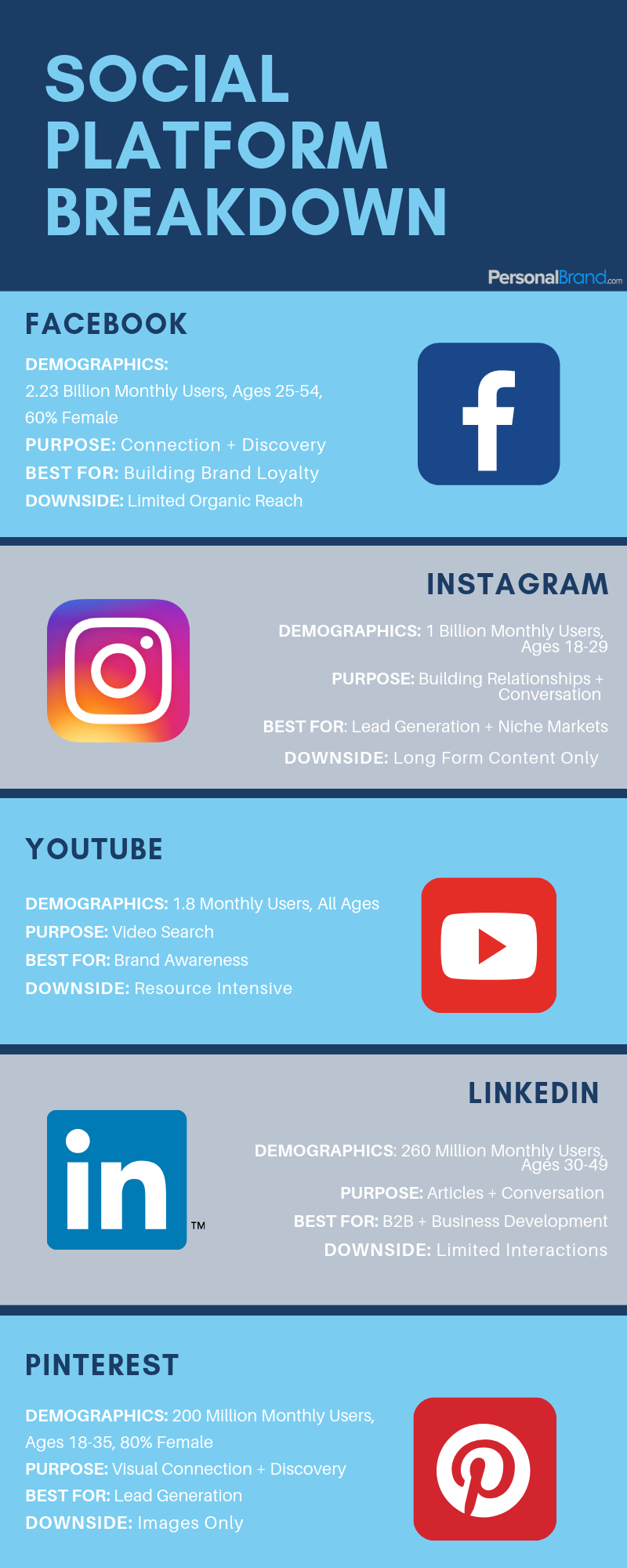Choosing the right social media platform for your personal brand can be challenging in a diverse and highly competitive online world.
Despite popular belief, you don’t need to be active on every social platform out there. In fact, prioritizing a majority of your time on one or two platforms that will provide the best results and heightened exposure is far more beneficial than trying to capitalize on every social platform out there leading to mediocre results.
But how do you choose the best social media platform for your personal brand?
Identify Your Target Audience
In order to determine which social platforms are most important for you to focus on, you must first know the type of people you are looking to reach.
If you haven’t done so already, creating an ideal “customer persona” will help you to narrow down the specifics of your audience and how your brand intertwines with the online social needs of your following.
Knowing your audience and demographics will allow you to fully capitalize on the style and ability of a particular platform, ultimately helping you to not only boost your online presence, but also meet specific business goals as well.
Identify Where Your Target Audience Lives
Once you have developed a clear picture of the audience you are looking to serve, you must then determine where those individuals are interacting online. For example, maintaining a presence on LinkedIn may be considered a wasted effort if you are trying to reach a primarily female audience.
In developing your social strategy, we recommend prioritizing social media demographics to help you solidify the platform best suited for your brand. The strongest of social media strategies utilize specific data-driven insights to cater content to the right audience, at the right time, on the right platform.
Consider using a social listening tool such as Hootsuite or Buffer to identify where your current social media following is spending most of their time. This tool will provide you with a plethora of demographics on your following such as gender, age and location data, which will help you to decide which social channels are worth pursuing and which aren’t.
To help you determine which social platform may be best for your personal brand, we have created this quick breakdown of the current social media user statistics for your use:

Data Sources: Facebook, Instagram, Pinterest, YouTube, LinkedIn, Accion
If you have yet to choose a channel, consider the insights that the Pew Research Center provides through their yearly social user analysis. This article outlines key demographics and social user statistics to guide you towards the social platform that is best for you.
Identify Where Your Competitors Are
Another great indicator of the platform you should be allocating your social media strategy towards is by keeping an eye on your competitors and the platforms that they are leveraging.
This will provide you with valuable insights into industry activity and determine what you should or should not be doing.
Some helpful guiding questions to answer when observing the activity of your competitors include:
- Where are your competitors spending most of their time?
- What kind of content are your competitors creating?
- How frequently are they posting?
- What level of engagement are they receiving?
- How are they “wowing” customers?
- Based on your findings, are their platforms that your competitors aren’t using that you should be?
- What platforms are your competitors ignoring, why do you think that is, and is there room for opportunity?
These questions will help you to get clarity around what is working for your industry and how you can top the competition.
Keep in mind that most people aren’t strategic with their social activities, so don’t just blindly mimic your competition as you could in turn be ignoring platforms that have the potential to be a huge win for you!
Ask Yourself: What Kind Of Content Do You Want To Share?
Perhaps the most crucial aspect of choosing your ideal social media platform is in the type of content that you create and share with the world. Strong social methods strategically align their content with platforms that complement their business goals and brand identity.
If you want to share image-based content
If you find yourself taking lots of pictures and have a love for showcasing your brand through high-quality images, consider prioritizing an image-heavy social channel such as Instagram or Pinterest.
With over 1 billion users, Instagram continues to provide a powerhouse of opportunities for those looking to boost their personal brands. Rich, storytelling images dictate this platform, allowing users to get a feel of your brand in a matter of seconds.
Pinterest may be a good option for you when seeking to create visual guides and captivating content.
If you want to share video content
There is no doubt that video content dominates the internet. Video content in all forms (including LIVE video) drives better engagement, increases conversions and is set to generate over 80% of all internet traffic by 2019.
Utilizing a video based platform may be right for you if you consistently publish, as it has the ability to exemplify your authentic self. Consider prioritizing YouTube, Instagram or Facebook as your social media base and watch your personal brand flourish.
If you want to share long form content
For those of you who love to dig deep and share your brand identity through research, blog posts, or tactical guides, platforms such as LinkedIn, Medium and Facebook will help complement your content.
LinkedIn is a great platform for B2B long-form messaging as it attracts business professionals and encourages intrinsic networking opportunities.
Medium was created to host long form content- and that’s what the audience expects!
As the world’s largest social network, Facebook is the jack of all trades- and has robust mediums of distributing all forms of content.
Final Thoughts:
Having focused discipline on one or two platforms is exponentially more powerful than distributing weak efforts across the multitude. All things considered, it’s best to drive your traffic off platform to your website as social media platforms constantly change.
Controlling the flow of information to your audience will help you keep consistent messaging and hedge against the “algorithm” changes of the social platforms.
Another thing to ensure is that you reserve your branded social handles in advance on any platforms that you foresee using in the future for increased consistency in your branding strategies. You don’t have to use them now, but you will sure be glad you have them reserved as your business grows!
Now that you have determined who needs your content, where they hang out and how to serve them, we want to know which factors are most important to you when choosing a social network.
What goes into your decision when selecting a content distribution and engagement platform?
If you enjoyed this post, be sure to join our private, Personal Brand Builders Community to stay up-to-date on the latest tools, strategies, and best practices for building your personal brand. It’s free… and awesome!
We hope you enjoyed this article, thanks for reading! Also, follow us on Facebook, and Twitter for updates every time we publish!


